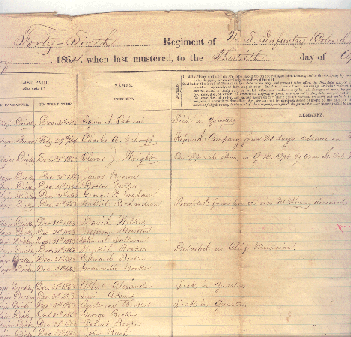27. Remick, Clarke H. "Untitled Report in Quarterly Returns of Ordinance and Ordinance Stores in Company A, 35th United States Colored Troops, First Quarter 1864." 31 March 1864. Clarke H. Remick Papers. Special Collections Library, Duke University.
Description: Quarterly report of the 35th United States Colored Troops, designated the 1st North Carolina Colored Troops until March 1864.
28. Remick, Clarke H. "Abstract of Expenditures in Quarterly Returns of Ordinance and Ordinance Stores in Company A, 35th United States Colored Troops, First Quarter 1864." 1864. Clarke H. Remick Papers. Special Collections Library, Duke University.
Description: Quarterly report of the 35th United States Colored Troops, designated the 1st North Carolina Colored Troops until March 1864.

29. "Muster Roll of Captain Squire N. Osburn's Company A of the Forty-Sixth Regiment of U.S. Infantry (Colored)..." 30 April 1864. U.S. Army. Units. Regiments, 46th U.S. Infantry (Colored) Papers, 1863-1864. Special Collections Library, Duke University.
Description: The muster roll shows the soldiers are former Arkansas slaves, many in service longer than their commanders. Some of the remarks relating to specific soldiers are also of note: Hesikiah Booker is the chief musician. [Click on the image for a larger version.]
30. Liberian Exodus Association. October 1878. "The Liberian Exodus" [Pamphlet Circulars Nos. 3 and 4]. Special Collections Library, Duke University.
Description: Circular of the Liberian Exodus Association, an organizaton dedicated to helping blacks resettle in Liberia.
Full title page information reads:
The Liberian Exodus; First Voyage of the Azor; Liberia A Delightful Country; Climate, Soil and Productions; Character of the People in Liberia and How They Live; Full Information on the Exodus Movement; The Steamship
31. Clay, Joseph. Letter to Louis Manigault. 9 September 1868. Louis Manigault Papers. (South Carolina) Special Collections Library, Duke University.
Description: Clay writes from Savannah, Georgia. It is unclear whether Bradley is a black man, or a radical white. The letter contains two interesting references concerning the social and political climate of the times--an allusion to blacks attacking white travelers and arming themsleves with the guns of those waylaid, and a reference to the political aspirations of a certain Bradley. The relevant sections are briefly abstracted below:
We have lately had a very brutal Murder to occur just outside our City. A young lad named Wilson went out...not returning in the afternoon his family became uneasy. He was missing for several days & then his body was found about 1 mile from the City. He was no doubt murdered by Negroes to get possession of his Gun which was a fine one. Several Negroes have been arrested upon suspicion. I never go outside the City without being armed with a Gun or Pistol for a rascally set of Negroes are prowling around the Country ready for any outragous deed of imfamy. You will see by the papers that we have got rid of the Negroes in our Legislature[.] I wish you could do the same in So. Ca., but they have the upper hand there. The `Nigger Bradley' made a Speech to the darkeys yesterday & threatended [?] every horrible thing against the poor Whites. He said the time would come when a man would not be permitted to sit in the State Legislature because he was `White.' Alas! What are we coming to?
32. Smith, Amanda. Amanda Smith' Own Story. Introduction. J. M. Thoburn. 1st ed. Chicago: Meyer & Brother Publishers, 1893. Special Collections Library, Duke University.
Description: Smith was born in slavery in Maryland in the 1830's. Her father purchased her freedom and moved her to Pennsylvania. She grew up there, helped runaway slaves, purchased a freeborn sister who had been sold into slavery, grew to be a missionary and taught in Africa.
Title page reads as follows:
33. "Rufus Watson Wharton's Farm Account Book." 1889-1903. David Miller Carter Papers. (North Carolina) Special Collections Library, Duke University.
Description: Writer tracks cotton picked and monies paid out to various agricultural laborers. Document is important because it lists labor and earnings of women, letting us figure how black women in this period contributed to overall household income through occassional field work in addition to various domestic labor.